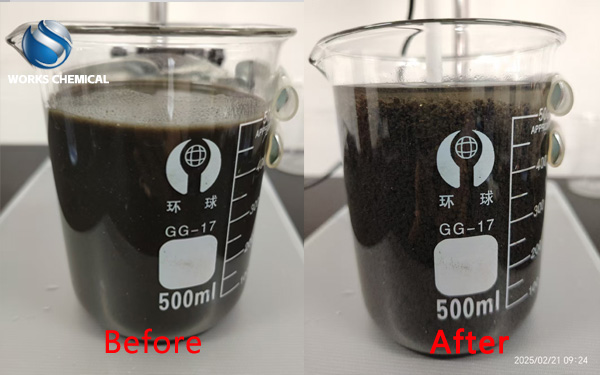
Deep in the biochemical tank of the sewage treatment plant, anaerobic sludge is quietly undertaking the core mission of degrading organic matter and stabilizing water quality. However, such sludge generally faces bottlenecks such as insufficient activity, poor sedimentation performance and low methane production efficiency. The emergence of sludge enhancers has provided an innovative solution to the problem of anaerobic sludge treatment and has become a key technology for promoting the resource utilization of sludge.
I. Challenges in Anaerobic Sludge Treatment

Activity inhibition
Toxic substances in industrial wastewater (such as heavy metals and phenolic compounds) can inhibit the activity of anaerobic microorganisms, leading to the accumulation of volatile fatty acids (VFA) and making the system prone to "acidification and collapse".
Poor sedimentation performance
The structure of the sludge flocs is loose and the sedimentation speed is slow, which leads to large fluctuations in the sludge concentration (MLSS) of the biochemical tank and unstable treatment efficiency.
Low methane production efficiency
The traditional anaerobic digestion cycle lasts for 20 to 30 days, resulting in low methane production, and the amount of excess sludge still accounts for 15% to 20% of the influent COD.
Ii. Mechanism of Action of Sludge Enhancer
Sludge enhancers specifically improve the performance of anaerobic sludge through the synergistic action of multiple components:
Microbial activation
Adding trace metal nutrients (such as Fe, Co, Ni) and vitamins can promote the synthesis of coenzymes by methanogenic bacteria and increase methane production.
Introduce virus-resistant bacterial strains to reduce the inhibition of toxic substances through biodegradation or adsorption.
Floc structure optimization
It contains cationic polymers, which increase the particle size of sludge flocs and enhance the sedimentation rate through electrical neutralization and bridging effects.
pH buffer regulation
Slow-release buffers (such as sodium bicarbonate and humic acid) can neutralize volatile fatty acids, maintain the stability of the system pH, and avoid the risk of acidification.
Iii. Application Scenarios and Effect Verification
Industrial wastewater treatment
In a sewage treatment plant of a certain chemical industrial park, for high-concentration organic wastewater, the enhancer has enhanced the anaerobic system's resistance to shock loads, increased the COD removal rate, and raised the methane production.
Anaerobic digestion of sludge
After applying the enhancer in a certain municipal sludge treatment plant, the digestion time was shortened, the gas production per ton of sludge increased, and at the same time, the amount of excess sludge decreased.
Emergency Response
In a certain pharmaceutical wastewater treatment plant, the enhancer enabled the system to stabilize within 24 hours and the concentration of VFA decreased.
Iv. Technical and Economic Analysis
Take an industrial sewage treatment plant with a daily processing capacity of 5,000 tons of wastewater as an example:
Direct cost: The cost of adding the enhancer is 5% of the total operating cost per ton of wastewater.
Efficiency improvement: Due to the increase in methane production, the annual revenue has risen. Sludge reduction reduces disposal costs.
Investment payback period: The equipment renovation and chemical input can be recovered within 12 months through cost savings and increased returns.
V. Industry Application Prospects
With the advancement of the "dual carbon" goals, the application of sludge enhancers in the field of anaerobic sludge treatment will present the following trends:
Customized development: Develop specialized enhancers for different wastewater qualities (such as food, chemical, and pharmaceutical industries) to enhance the accuracy of treatment.
Low-carbon upgrade: By integrating cogeneration technology, sludge treatment and energy recovery are coordinated to contribute to the carbon neutrality goal.
Intelligent control and management: The dosage of the enhancer is adjusted in real time through the online monitoring system to achieve dynamic optimization.
Sludge enhancers not only provide a technological breakthrough for anaerobic sludge treatment, but also promote the transformation of the industry from a "cost center" to a "profit center". In the future, with the integrated innovation of materials science and biotechnology, sludge enhancers are expected to become the core driving force for green development in the field of sewage treatment.